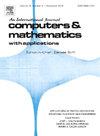Structure deformation analysis of the deep excavation based on the local radial basis function collocation method
IF 2.9
2区 数学
Q1 MATHEMATICS, APPLIED
引用次数: 0
Abstract
This study introduces a local radial basis function collocation method (LRBFCM) to analyzing structural deformation in deep excavation within a two dimensional geotechnical model. To mitigate the size effect caused by a large length-to-width ratio, a technique known as the ‘direct method’ is employed. This method effectively reduces the influence of the shape parameter, thereby improving the accuracy of the partial derivative calculations in LRBFCM. The combination of LRBFCM with the direct method is applied to the deep excavation problem, which consists of both the soil and support structures. The soil is modeled using the Drucker-Prager (D-P) elastic-plastic model, while an elastic model is employed for the support structure. Elastic-plastic discretization is performed using incremental theory. The proposed approach is validated through four different examples, comparing the results with numerical solutions obtained from traditional finite element methods (FEM). This study advocates the use of the direct method to optimize the distribution of local influence nodes, particularly in cases involving large length-to-width ratios. The combination of LRBFCM with incremental theory is shown to be effective for addressing elastic-plastic problems.
基于局部径向基函数配准法的深基坑结构变形分析
本研究介绍了一种局部径向基函数搭配法(LRBFCM),用于分析二维岩土模型中深层开挖的结构变形。为减轻大长宽比引起的尺寸效应,采用了一种称为 "直接法 "的技术。这种方法可有效减少形状参数的影响,从而提高 LRBFCM 偏导数计算的精度。LRBFCM 与直接法的结合应用于深层开挖问题,该问题由土壤和支撑结构组成。土壤采用德鲁克-普拉格(D-P)弹塑性模型,支撑结构采用弹性模型。弹塑性离散化采用增量理论。通过四个不同的实例对所提出的方法进行了验证,并将结果与传统有限元方法(FEM)获得的数值解进行了比较。本研究提倡使用直接法优化局部影响节点的分布,特别是在涉及大长宽比的情况下。研究表明,将 LRBFCM 与增量理论相结合可有效解决弹塑性问题。
本文章由计算机程序翻译,如有差异,请以英文原文为准。
求助全文
约1分钟内获得全文
求助全文
来源期刊

Computers & Mathematics with Applications
工程技术-计算机:跨学科应用
CiteScore
5.10
自引率
10.30%
发文量
396
审稿时长
9.9 weeks
期刊介绍:
Computers & Mathematics with Applications provides a medium of exchange for those engaged in fields contributing to building successful simulations for science and engineering using Partial Differential Equations (PDEs).
 求助内容:
求助内容: 应助结果提醒方式:
应助结果提醒方式:


